Wide Shot
The wide shot is primarily used to
establish the setting or location of a scene. Since objects appear small in
the frame, it can also be used for de-emphasis and is ideal for
conveying character isolation. This shot from Vertigo
accomplishes both of these goals:
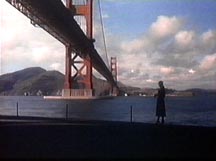
The wide shot has two drawbacks: it
weakens the director's control over audience attention and lessens the
impact of action. It should be avoided when important detail must be
conveyed. Wide shots are also referred to as establishing shots.
Close Shot
The close shot is the exact
opposite of the wide shot in that the subject is very large in the frame.
Consequently, it is used for emphasis. When the subject is an actor,
anything closer than mid-chest is considered a close shot, or close-up.
Here, the actor's head dominates the composition. There are several types of
actor close shots, as illustrated in this still from The
Godfather:
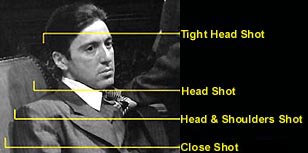
Another variation is the over the
shoulder shot, where an actor is seen in close-up over another actor's
shoulder. This shot is often used in dialogue scenes as a bridge between a
shot of two actors and a close-up:

The close shot is a powerful tool and
should be used sparingly. When used too often, the audience becomes
desensitized to it and its effectiveness is lost.
Medium Shot
As the name indicates, the medium shot
falls between the close shot and the wide shot. When the subject is an
actor, the upper body dominates the frame, usually from the thighs up.
Movies are primarily constructed of medium shots, with wide shots and close
shots used for orientation and emphasis, respectively.
Multiple Sizes
A composition can have multiple subject
sizes. For example, one actor can be shown in close-up, while another is in
full shot. This enables the audience to follow action in the foreground and
the background simultaneously. The technique, called deep focus,
was pioneered by Orson
Welles in his landmark film Citizen
Kane. The following shot shows actors in close, medium, and full
shot:
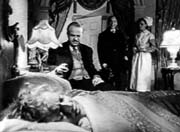
Variable Size
The size of a subject can be varied
during a shot by moving the camera and/or subject. For example, an actor in
medium shot can move away from the camera into wide shot or toward the
camera into close-up. This shot from Shadow
of a Doubt moves from a medium shot to an extreme close shot:
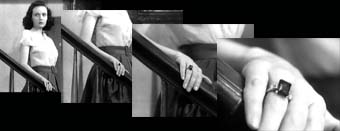
Cutting Heights
There must be a clear understanding
between director and cinematographer as to where frame lines cut off the
actor's body. These designations are called cutting heights:
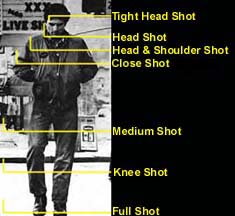
A rule in cutting heights is that frame
lines should not cut through an actor's primary joints, since this has a
strange look on screen. Primary joints include the neck, waist, knees, and
ankles. The director should be aware that terminology may vary slightly from
one cinematographer to the next, so definitions should be clearly
established before shooting begins.
Technical
Considerations
The preferred way to change subject size
is to move the camera in relation to the subject, or vice versa. Subject
size can also be varied by changing the lens focal length (i.e.,
magnification), however, this affects the way the image looks in terms of
depth perspective and depth of field:
Depth Perspective - Depth
perspective is the apparent distance of the foreground and background in
relation to each other. Wide focal lengths expand the apparent distance,
while long focal lengths compress it.
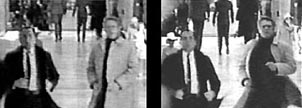
Variation in Depth Perspective
(note size of people in background)
Depth of Field -
Depth of field is the amount of
acceptable focus behind and in front of the subject. Short focal lenses
tend to produce a wide depth of field, where everything on the set appears
in focus ("deep focus"). Long focal lenses produce a shallow depth of
field, where only the subject area is in focus.
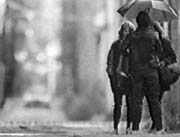
Shallow Depth of Field
To avoid fluctuations in these variables
from one shot to the next, the cinematographer chooses a focal length and
shoots the entire scene with that lens. The camera is then moved in relation
to the subject to create the desired subject size.